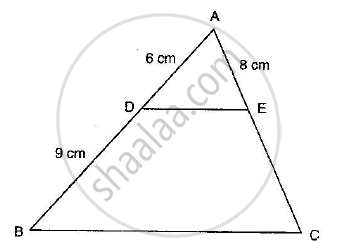Advertisements
Advertisements
प्रश्न
If ∆ABC and ∆DEF are two triangles such tha\[\frac{AB}{DE} = \frac{BC}{EF} = \frac{CA}{FD} = \frac{2}{5}\] , then Area (∆ABC) : Area (∆DEF) =
विकल्प
2:5
4 : 25
4 : 15
8 : 125
उत्तर
Given: ΔABC and ΔDEF are two triangles such that `(AB)/(DE)=(BC)/(EF)=(CA)/(FD)=2/5`
To find: `\text{Ar(Δ ABC): Ar(Δ DEF)}`
We know that if the sides of two triangles are proportional, then the two triangles are similar.
Since `(AB)/(DE)=(BC)/(EF)=(CA)/(FD)=2/5`, therefore, ΔABC and ΔDEF are similar.
We know that the ratio of areas of two similar triangles is equal to the ratio of squares of their corresponding sides.
`\text{Ar(Δ ABC)}/\text{Ar(Δ DEF)}=(AB)^2/(DE)^2`
`\text{Ar(Δ ABC)}/\text{Ar(Δ DEF)}=2^2/5^2`
`\text{Ar(Δ ABC)}/\text{Ar(Δ DEF)}=4/25`
Hence the correct answer is `b`
APPEARS IN
संबंधित प्रश्न
Diagonals AC and BD of a trapezium ABCD with AB || DC intersect each other at the point O. Using similarity criterion for two triangles, show that `"OA"/"OC"="OB"/"OD"`.
In a ΔABC, AD is the bisector of ∠A.
If AB = 5.6cm, AC = 4cm and DC = 3cm, find BC.

In ∆ABC, ∠ABC = 135°. Prove that AC2 = AB2 + BC2 + 4 ar (∆ABC)
State basic proportionality theorem and its converse.
In the adjoining figure, find AC.

State SSS similarity criterion.
The lengths of the diagonals of a rhombus are 30 cm and 40 cm. Find the side of the rhombus.
In a ∆ABC, AD is the bisector of ∠BAC. If AB = 8 cm, BD = 6 cm and DC = 3 cm. Find AC
In the given figure, if PB || CF and DP || EF, then \[\frac{AD}{DE} =\]
In a ∆ABC, ∠A = 90°, AB = 5 cm and AC = 12 cm. If AD ⊥ BC, then AD =
